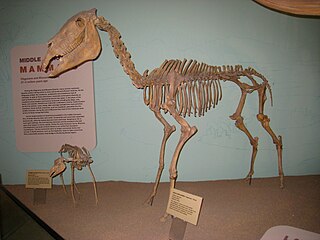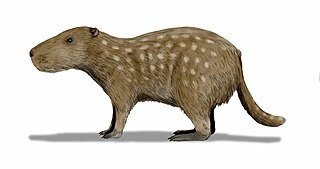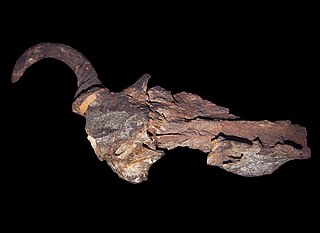 W
WCanis cedazoensis is an extinct species of smaller canid which was endemic to North America during the Pleistocene epoch, 1.8 Ma—300,000 years ago.
 W
WCanis edwardii is an extinct species of genus Canis which was endemic to most of North America from the Late Blancan stage of the Pliocene epoch through to the Irvingtonian stage of the Pleistocene epoch, living 2.3 million years ago (Mya)—300,000 years ago, existing for about 2 million years .
 W
WCapromeryx was a genus of dwarf pronghorns (Antilocapridae) that originated in North America during the Pliocene about 5 million years ago. The closest living relative and only surviving member of the family is the North American pronghorn. Capromeryx furcifer is one of the smallest artiodactlys known, being 24 inches (61 cm) at the shoulder and 25 pounds (11 kg) in weight.
 W
WCervalces is an extinct deer genus that lived during the Pliocene and Pleistocene epochs. Cervalces gallicus, the ancestral species, lived in Europe from the Pliocene to the Pleistocene strata. Cervalces scotti, the stag-moose, lived in Pleistocene North America. Cervalces latifrons, the broad-fronted moose, and Cervalces carnutorum were found in Pleistocene Europe and Asia.
 W
WCoelodonta is an extinct genus of rhinoceros that lived in Eurasia between 3.7 million years to 10,000 years before the present, in the Pliocene and the Pleistocene epochs.
 W
WCuvieronius is an extinct New World genus of gomphotheres and is named after the French naturalist Georges Cuvier. Alive, specimens typically stood about 2.3 m (7.5 ft) tall at the shoulder, weighed about 3.5 t and would have superficially resembled a modern elephant with spiral-shaped tusks.
 W
WDamalops is an extinct genus of Alcelaphinae. It lived during the Pliocene and Pleistocene in southern Asia, where the species Damalops palaeindicus is known from the Siwaliks in the northern part of the Indian Subcontinent.
 W
WDinofelis is a genus of extinct sabre-toothed cats belonging to the tribe Metailurini. They were widespread in Europe, Asia, Africa and North America at least 5 million to about 1.2 million years ago. Fossils very similar to Dinofelis from Lothagam range back to the Late Miocene, some 8 million years ago.
 W
WElephants are mammals of the family Elephantidae and the largest existing land animals. Three species are currently recognised: the African bush elephant, the African forest elephant, and the Asian elephant. Elephantidae is the only surviving family of the order Proboscidea; extinct members include the mastodons. The family Elephantidae also contains several now-extinct groups, including the mammoths and straight-tusked elephants. African elephants have larger ears and concave backs, whereas Asian elephants have smaller ears, and convex or level backs. Distinctive features of all elephants include a long proboscis called a trunk, tusks, large ear flaps, massive legs, and tough but sensitive skin. The trunk is used for breathing, bringing food and water to the mouth, and grasping objects. Tusks, which are derived from the incisor teeth, serve both as weapons and as tools for moving objects and digging. The large ear flaps assist in maintaining a constant body temperature as well as in communication. The pillar-like legs carry their great weight.
 W
WEquus scotti is an extinct species of Equus, the genus that includes the horse.
 W
WEucladoceros or bush-antlered deer is an extinct genus of deer whose fossils have been discovered in Europe, the Middle East and Central Asia. This genus was formally described by Hugh Falconer in 1868.
 W
WThe Hagerman horse, also called the Hagerman zebra or the American zebra, was a North American species of equid from the Pliocene epoch and the Pleistocene epoch. It was one of the oldest horses of the genus Equus and was discovered in 1928 in Hagerman, Idaho. It is the state fossil of Idaho.
 W
WHaringtonhippus is an extinct genus of stilt-legged horse from the Pleistocene of North America first described in 2017. The genus is monospecific, consisting of the species H. francisci, initially described in 1915 by Oliver Perry Hay as Equus francisci. Prior to its formal description, it was sometimes referred to as the New World stilt-legged horse.
 W
WThe High Arctic camel, from the mid-Pliocene epoch, is a fossil camel related to the fossil genus Paracamelus from which modern camels arose. It is also related to the extinct Ice Age Yukon giant camel. Collagen-containing fossils were found in 2006 near Strathcona Fiord on Ellesmere Island in Nunavut, Canada. The High Arctic camel lived at least 3.4 million years ago during a warmer period in a boreal-type forest environment.
 W
WHippidion is an extinct genus of horse that lived in South America from the Late Pliocene to the end of the Late Pleistocene (Lujanian), between two million and 11,000 years ago. They were one of two lineages of equines native to South America during the Pleistocene epoch alongside those of the Equus subgenus Amerhippus.
 W
WJosephoartigasia monesi, an extinct species of South American caviomorph rodent, is the largest rodent known, and lived from about 4 to 2 million years ago during the Pliocene to early Pleistocene. The species is one of two in the genus Josephoartigasia, the other being J. magna. J. monesi is sometimes called the giant pacarana, after its closest living relative, the pacarana in the family Dinomyidae. The species may have weighed a ton, orders of magnitude larger than any currently living rodent.
 W
WLoxodonta atlantica is an extinct species of elephant in the genus Loxodonta, from Africa. It was larger than the modern African elephant, with more progressive dentition. It includesPleistocene fossils from Ternifine, Middle Pleistocene fossils from Elandsfontein and Late Pliocene fossils from the Omo River, with a final dating in the Late Pleistocene. L. atlantica was said to probably derive from L. adaurora; however, an analysis in 2009 suggested that L. atlantica evolved from L. exoptata, and is ancestral to L. africana. The species is divided into two subspecies: L. atlantica atlantica and L. atlantica zulu. The type for Loxodonta atlantica is housed in the Muséum national d'histoire naturelle in Paris, but is listed without a specimen number.
 W
WMakapania is an extinct genus of large caprine or ovibovine from the Pliocene and Pleistocene of southern and East Africa. It is remarkable in that its horns were positioned laterally. Its body weight is estimated to have been about 263 kg.
 W
WMegalotragus was a genus of very large extinct African alcelaphines that occurred from the Pliocene to early Holocene. It resembled modern hartebeests, but differed in larger body size, it includes the largest bovids in the tribe Alcelaphini, reaching a shoulder height of 1.4 m (4.6 ft). The genus consists of three species of which Megalotragus priscus survived until the early Holocene 7.500 C14yBP.
 W
WMylohyus is an extinct genus of peccary found in North and Central America. It evolved in the Pliocene and its extinction is probably as recent as 9,000 years ago. It would have been familiar with early humans.
 W
WOrcinus paleorca is an early species of killer whale from the Middle Pleistocene of Japan known only from a single tooth fragment.
 W
WPachycrocuta was a genus of prehistoric hyenas. The largest and most well-researched species is Pachycrocuta brevirostris, colloquially known as the giant short-faced hyena as it stood about 90–100 cm (35–39 in) at the shoulder and it is estimated to have averaged 110 kg (240 lb) in weight, approaching the size of a lioness, making it the largest known hyena. Pachycrocuta first appeared during the late Miocene and became extinct during the middle Pleistocene, 400,000 years ago.
 W
WParacamelus is an extinct genus of camel in the family Camelidae. It originated in North America during the Middle Miocene but crossed the Beringian land bridge into Eurasia during the Late Miocene, approximately 7.5–6.5 Ma; its later range spanned from Spain and Italy to Chad and Shanxi Province, China. It is ancestral to living camels of the genus Camelus. A population remained in northern North America, which became the high Arctic camel, which survived until the Middle Pleistocene approximately 1 Ma.
 W
WPelorovis is an extinct genus of African wild cattle, which first appeared in the very beginning of the Pleistocene, 2.5 million years ago, and became extinct at the end of the Late Pleistocene about 12,000 years ago or even during the Holocene, some 4,000 years ago.
 W
WSivatherium is an extinct genus of giraffids that ranged throughout Africa to the Indian subcontinent. The species Sivatherium giganteum is, by weight, one of the largest giraffid known, and also one of the largest ruminants of all time. The Afro-Asiatic species, S. maurusium, was once placed within the genus "Libytherium".
 W
WSthenurinae is a subfamily within the marsupial family Macropodidae, known as 'short faced kangaroos'. No members of this subfamily are extant today, with all becoming extinct by the late Pleistocene. Procoptodon goliah, the largest macropodid known to have existed, was a sthenurine kangaroo, but sthenurines occurred in a range of sizes, with Procoptodon gilli being the smallest at the size of a small wallaby.